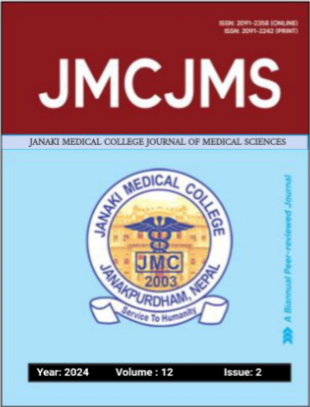Spectrum of diseases and injuries presentation among patients visiting Emergency Department at Janaki Medical College Teaching Hospital
DOI:
https://doi.org/10.3126/jmcjms.v12i02.69147Keywords:
Disease spectrum, Emergency department, Injury patterns, Non-communicable diseases (NCDs)Abstract
Background & Objectives: The Global Burden of Disease study is a systemic effort to quantify the comparative magnitude of the health loss due to diseases, injuries and risk factors by age, sex and geographies in specific point of time. Five out of ten causes of disease burden in 2017 in Nepal are Non-Communicable Disease (NCDs), ischemic heart disease (IHD), Chronic Obstructive Pulmonary Disease (COPD), Lower Respiratory Tract Infection (LRTI) and Tuberculosis (TB). We aimed to find out the demographic, clinical presentation and outcome of Emergency patients at Janaki Medical College Teaching Hospital (JMCTH) Emergency department.
Materials and Methods: A descriptive observational study of patients visiting ED at Janaki Medical College, Ramdaiya, Bhawadi, Dhanusha. Distinctiveness of adult patients who entered the emergency department (ED) in a hospital in Nepal were prospectively recorded in the local emergency registry from 2023-04-15 to 2023-07-18. Post-ED mortality, patient households were followed-up by telephone interviews at 90 days. Patients were diagnosed, treated and admitted in different wards for further evaluation and treatment. Data were collected, analyzed, interpreted, using SPSS version 20.
Results: The majority of patients were male (55.58%) predominantly from Dhanusha (79.4%). Common symptoms included musculoskeletal pain (16.5%), abdominal pain (13.3%), and fever (9.9%). The most common diseases were acute pain abdomen (21.26%) and hypertension (11.06%), Abrasions (35%) and cut injuries (13.59%) were the most frequent injuries. Most of the patients were admitted to the observation ward (52.9%).
Conclusion: Most patients attending emergency department were young males from Dhanusha, primarily of Terai Madheshi and other castes. The results emphasize the necessity of better emergency care services and public health initiatives in Janakpurdham, as well as the critical role of emergency departments which provides services in wide range of acute and chronic diseases.
Downloads
Downloads
Published
How to Cite
Issue
Section
License
© JMCJMS, JMC, Janakpur, Nepal




